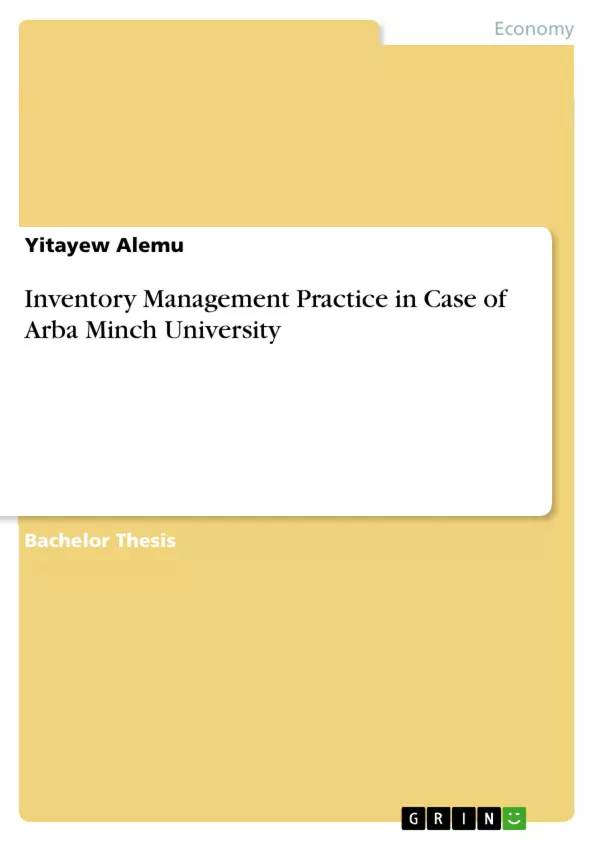Effective inventory management is a tool to run the organization property. Therefore, assessments of inventory management have a vital role. This is the reason why the study is conducted. To conduct this research, applying descriptive research is believed to be appropriate. In this study census was used, because it increase research quality and the population size is less than 100. To get relevant data both primary and secondary data were collected. After the data collection process ends, it was analyzed by descriptive statistics like percentage and table.
This study was conducted in ArbaMinch University. Based on the findings of the study, the researcher forward feasible recommendation so as to help the organization overcome its inventory management related problems. The major finding of the study indicates that the inventory management practices of the university were poor.
Inhaltsverzeichnis (Table of Contents)
- Acknowledgement
- Table of content
- List of table...
- Abstract...
- CHAPTER ONE
- 1. Introduction...
- 1.1. Background of the study..
- 1.2. Statement of the problem..
- 1.3. Objective of the study..
- 1.3.1. Specific objective..
- 1.4. Re-search method..
- 1.4.1. Re-search design...
- 1.4.2. Sampling technique and sample size..
- 1.4.3. Method of data collection........
- 1.4.4. Method of data analysis..
- 1.5. Significant of the study..
- 1.6. Scope of the study..
- 1.7. Limitation of study..
- CHAPTER TWO
- 2. Literature review
- 2.1. Definition of inventory..
- 2.2. Inventory management….
- 2.3. Objective of inventory management…...
- 2.4.Need of inventory……
- 2.5. Inventory store/storage....
- 2.5.1. Types of stores.
- 2.6. Function of inventory management…....
- 2.7. Aim of inventory management…
- 2.8. Types of inventory...
- 2.9. Cost of inventory
- 2.10. Alternative inventory system…………….
- 2.11. Inventory control...
- 2.12. Inventory costing...
- 2.13. Stock taking……
- 2.14. Re-order point.
- 2.15. Inventory decision...
- 2.16. Inventory-management model...
- CHAPTER THREE
- 3. Data Analysis and Presentation
- 3.1. Demographic characteristics of respondents....
- 3.2. Analysis and Interpretation of the data..
- CHAPTER FOUR
- 4. Summary of major findings, conclusion and recommendation....
- 4.1. Summary of major findings…....
- 4.2. Conclusion........
- 4.3. Recommendation..
- References
- Appendix
Zielsetzung und Themenschwerpunkte (Objectives and Key Themes)
This research project, conducted at Arba Minch University, aims to assess the inventory management practices within the university. The primary objective is to analyze the current inventory management system and identify potential areas for improvement. The study aims to understand the effectiveness of current practices and provide recommendations for optimizing inventory management within the university context.
- Effectiveness of Inventory Management Systems
- Cost Management and Inventory Optimization
- Inventory Control and Stock Management Techniques
- Impact of Inventory Management Practices on University Operations
- Recommendations for Improvement and Best Practices
Zusammenfassung der Kapitel (Chapter Summaries)
The research project delves into the topic of inventory management practices at Arba Minch University. Chapter one introduces the study by establishing its background, identifying the research problem, and outlining the specific objectives of the study. It also clarifies the research methodology, including the data collection and analysis techniques. The chapter emphasizes the significance of the research project, its scope, and any limitations encountered.
Chapter two engages in an extensive review of relevant literature, encompassing various aspects of inventory management. It provides a clear definition of inventory, explores the intricacies of inventory management practices, and details the objectives and needs associated with effective inventory management. This chapter also delves into the types of inventory, associated costs, alternative inventory systems, and methods of inventory control, costing, and stock taking. Furthermore, it examines the significance of reorder points, inventory decisions, and commonly employed inventory management models.
Chapter three delves into the analysis and presentation of data gathered during the research. It commences by examining the demographic characteristics of the respondents. The chapter then proceeds to analyze and interpret the data collected, providing insights into the practices, challenges, and potential areas for improvement within Arba Minch University's inventory management system.
Schlüsselwörter (Keywords)
The study focuses on the inventory management practices at Arba Minch University, encompassing key concepts such as inventory control, stock management, cost optimization, and effective utilization of resources. The research examines different inventory management systems, techniques, and models, aiming to provide practical recommendations for improving the university's overall inventory management practices.
- Quote paper
- Yitayew Alemu (Author), 2014, Inventory Management Practice in Case of Arba Minch University, Munich, GRIN Verlag, https://www.grin.com/document/381182



